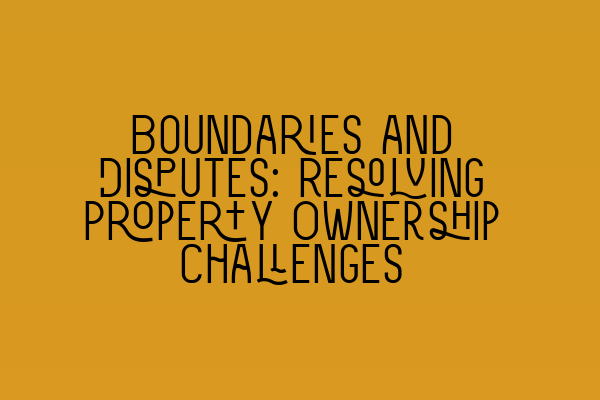Boundaries and Disputes: Resolving Property Ownership Challenges
When it comes to property ownership, one of the most common challenges that can arise is boundary disputes. These disputes can be a major headache for property owners, causing stress, tension, and potentially leading to expensive legal battles. In this blog post, we will explore the various aspects of boundary disputes, offer valuable insights on how to address them, and provide advice on resolving these challenges effectively.
Understanding Boundary Disputes
Boundary disputes typically occur when neighbors disagree on the exact location or ownership of a property boundary. Such disputes can arise due to various reasons, including unclear land descriptions, conflicting survey records, or simply a lack of communication between adjacent property owners.
It’s important to remember that accurate boundary identification is crucial for maintaining a clear and harmonious property ownership framework. When boundaries are in dispute, it can affect not only the property owners’ rights but also impact any future property transactions or developments.
Resolving Boundary Disputes: Steps to Take
If you find yourself embroiled in a boundary dispute, there are several key steps you can take to resolve the issue in an efficient and peaceful manner:
1. Communicate:
The first and most important step is to open lines of communication with your neighbor. Engage in a friendly, respectful conversation to discuss your concerns and try to resolve the issue amicably. Often, misunderstandings can be resolved through open dialogue, ensuring both parties are aware of their rights and responsibilities.
2. Conduct Research:
Perform thorough research into historical documents, land surveys, and property deeds. These documents can provide valuable evidence to establish the true boundaries of your property. It may be necessary to consult with a professional surveyor or solicitor to help interpret and evaluate this information accurately.
3. Mediation:
In cases where direct communication fails to yield a resolution, seeking mediation can be a productive next step. Engaging the services of a neutral third party, such as a mediator or arbitrator, can help facilitate a fair and unbiased negotiation between the parties involved. Mediation can often lead to a mutually acceptable agreement and help avoid protracted legal battles.
4. Legal Advice:
If all other attempts have been exhausted without success, it may be necessary to seek legal advice from a qualified property solicitor. They can guide you through the legal processes and ensure your rights are protected. A solicitor with expertise in property law and boundary disputes will have the experience necessary to analyze the evidence and present your case effectively.
Key Takeaways
Boundary disputes can be complex and emotionally charged, but with the right approach, they can be resolved in a satisfactory manner. Here are a few key takeaways to keep in mind when facing a boundary dispute:
- Effective communication and respectful dialogue are often the first steps towards resolving a boundary dispute.
- Thorough research, including historical documents and professional surveys, can provide evidence to support your claim.
- Mediation can be a productive method to reach a mutually acceptable solution.
- Legal advice from a property solicitor can help navigate the legal complexities of a boundary dispute.
If you’re currently facing a boundary dispute or need professional advice on property ownership matters, SQE Property Law & Land Law can provide expert assistance. Our team of experienced property solicitors specializes in resolving boundary disputes and ensuring our clients’ property rights are protected. Contact us today to discuss your situation and explore your legal options.
